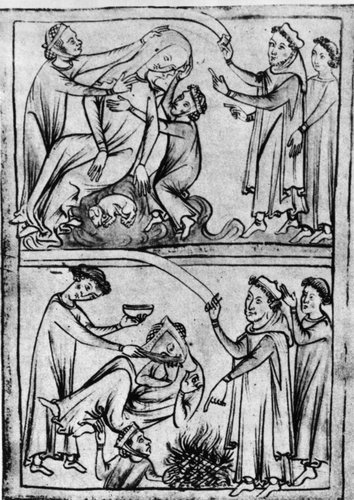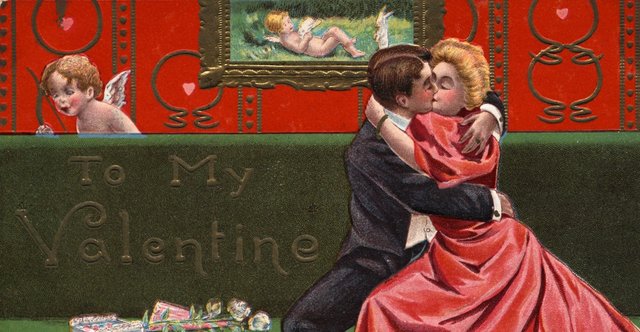February 14th that time of year where forced merriment is at its highest!
Where did this holiday come from? How did it all start? Let’s dive in and find the history!

The History, let’s begin!
Valentine's Day is touted as a time to celebrate romance and love, but the origins of this festival of candy and cupids are actually dark, bloody — and a bit muddled. Every February 14, across the US and in other places around the world, candy, flowers and gifts are exchanged between loved ones, all in the name of St. Valentine. But who is this mysterious saint, and where did these traditions come from?
Though no one has pinpointed the exact origin of the holiday, one good place to start is ancient Rome, where men hit on women by, well, hitting them.
Lupercalia
Lupercalia was a fertility festival dedicated to Faunus, the Roman god of agriculture, as well as to the Roman founders Romulus and Remus.
From Feb. 13 to 15, the Romans celebrated the feast of Lupercalia. To begin the festival, members of the Luperci, an order of Roman priests, would gather at a sacred cave where the infants Romulus and Remus, the founders of Rome, were believed to have been cared for by a she-wolf or lupa. The priests would sacrifice a goat, for fertility, and a dog, for purification. They would then strip the goat’s hide into strips, dip them into the sacrificial blood and take to the streets, gently slapping both women and crop fields with the goat hide. Far from being fearful, Roman women welcomed the touch of the hides because it was believed to make them more fertile in the coming year. The Roman romantics "were drunk. They were naked," says Noel Lenski, a historian at the University of Colorado at Boulder. Later in the day, according to legend, all the young women in the city would place their names in a big urn. The city’s bachelors would each choose a name and become paired for the year with his chosen woman. These matches often ended in marriage.
The ancient Romans may also be responsible for the name of our modern day of love. Emperor Claudius II executed two men — both named Valentine — on Feb. 14 of different years in the 3rd century A.D. Their martyrdom was honored by the Catholic Church with the celebration of St. Valentine's Day.
Later, Pope Gelasius I muddled things in the 5th century by combining St. Valentine's Day with Lupercalia to expel the pagan rituals. But the festival was more of a theatrical interpretation of what it had once been. Lenski adds, "It was a little more of a drunken revel, but the Christians put clothes back on it. That didn't stop it from being a day of fertility and love."
Around the same time, the Normans celebrated Galatin's Day. Galatin meant "lover of women." That was likely confused with St. Valentine's Day at some point, in part because they sound alike.
THE LEGEND OF ST. VALENTINE

A drawing depicts the death of St. Valentine — one of them, anyway. The Romans executed two men by that name on Feb. 14 of different years in the 3rd century A.D.
The history of Valentine’s Day and the story of its patron saint is shrouded in mystery. We do know that February has long been celebrated as a month of romance, and that St. Valentine’s Day, as we know it today, contains vestiges of both Christian and ancient Roman tradition. But who was Saint Valentine, and how did he become associated with this ancient rite?
The Catholic Church recognizes at least three different saints named Valentine or Valentinus, all of whom were martyred. One legend contends that Valentine was a priest who served during the third century in Rome. When Emperor Claudius II decided that single men made better soldiers than those with wives and families, he outlawed marriage for young men. Valentine, realizing the injustice of the decree, defied Claudius and continued to perform marriages for young lovers in secret. When Valentine’s actions were discovered, Claudius ordered that he be put to death.
VALENTINE’S DAY: A DAY OF ROMANCE
Lupercalia survived the initial rise of Christianity and but was outlawed—as it was deemed “un-Christian”–at the end of the 5th century, when Pope Gelasius declared February 14 St. Valentine’s Day. It was not until much later, however, that the day became definitively associated with love. During the Middle Ages, it was commonly believed in France and England that February 14 was the beginning of birds’ mating season, which added to the idea that the middle of Valentine’s Day should be a day for romance.
Valentine greetings were popular as far back as the Middle Ages, though written Valentine’s didn’t begin to appear until after 1400. The oldest known valentine still in existence today was a poem written in 1415 by Charles, Duke of Orleans, to his wife while he was imprisoned in the Tower of London following his capture at the Battle of Agincourt. (The greeting is now part of the manuscript collection of the British Library in London, England.) Several years later, it is believed that King Henry V hired a writer named John Lydgate to compose a valentine note to Catherine of Valois.
In addition to the United States, Valentine’s Day is celebrated in Canada, Mexico, the United Kingdom, France and Australia. In Great Britain, Valentine’s Day began to be popularly celebrated around the 17th century. By the middle of the 18th, it was common for friends and lovers of all social classes to exchange small tokens of affection or handwritten notes, and by 1900 printed cards began to replace written letters due to improvements in printing technology. Ready-made cards were an easy way for people to express their emotions in a time when direct expression of one’s feelings was discouraged. Cheaper postage rates also contributed to an increase in the popularity of sending Valentine’s Day greetings.

A Valentine's Day postcard from around 1909.
Americans probably began exchanging hand-made valentines in the early 1700s. In the 1840s, Esther A. Howland began selling the first mass-produced valentines in America. Howland, known as the “Mother of the Valentine,” made elaborate creations with real lace, ribbons and colorful pictures known as “scrap.” Today, according to the Greeting Card Association, an estimated 1 billion Valentine’s Day cards are sent each year, making Valentine’s Day the second largest card-sending holiday of the year. (An estimated 2.6 billion cards are sent for Christmas.) Women purchase approximately 85 percent of all valentines.
Today, the holiday is big business: According to market research firm IBIS World, Valentine's Day sales reached $17.6 billion last year; this year's sales are expected to total $18.6 billion. NOTE: These figures were taken from 2011.
All facts, figures, images came from either one of these sources.
Source 1 , Source 2
Congratulations if you have made it this far into the post! Thanks for reading the whole thing! If we are to celebrate holidays and traditions, I feel we should at least take the time to know the history of them and how they got started and why.

You can also find me on Sola, the Twitter replacement, under username simms50, https://sola.ai/simms50
Your upvote is always appreciated.
Please resteem and leave a comment below!
Shalom(Peace)

Just give me my Godiva white chocolate and no one gets hurt!
And no I don't care what day it is, you can play it safer by giving them 7 days a week ;-)
Now THAT is a good attitude...chocolate all year around!!!! Thanks for stopping in and leaving a comment!
Thanks for pulling this all together. We started only celebrating God’s holidays two years ago and have been blessed by the purity and joy of them. I always wondered about what the deal was with Valentines Day.
I remember always hearing that those were the feasts of the Jews but that is not what Leviticus 23:2 says....“Speak to the children of Israel, and say to them: ‘The feasts of the Lord, which you shall proclaim to be holy convocations, these are My feasts. It was there all the time MY FEASTS! His feasts are a joy and I look forward to them! Thanks for stopping by, also please make sure to do so often as I try to post some daily devotions/verse of the days throughout the week for encouragement! Shalom!
I liked your comment: If we are to celebrate holidays and traditions, I feel we should at least take the time to know the history of them and how they got started and why. I love the verse in 1 Thessalonians 5:21-22 which says, "Prove all things; hold fast that which is good. Abstain from all appearance of evil."
It’s funny how most people celebrate EVERTHING but the lords feast and holy days. No it’s not funny at all
Not it is not funny, sad really. Most Christians want to celebrate Jesus and so I ask them then why do you not celebrate him with the Holidays that are actually in the Bible? I don't really get a good answer back to this question.....
When I started walking in the Father's way this was one of the items I had to tackle...all the worldly holidays! Thanks for leaving a comment!
Great post. I think it is funny how most Americans just celebrate whatever without having any idea what it is they r actually doing. Keep up the good work
And especially now as everything has been "cleaned up" and now looks nice and fun and innocent! I knew that if I was going to walk the way the Father walks then most of these worldly holidays had to go! Thanks for leaving a comment, I enjoy the interaction!!!
The truth will set you free! Well some of us anyway lol
It will to those that truly want to be free, because I don't want to hear ...
Matt 7:21-23 also
That one is probably the one that makes me shudder the most!
8.90% @pushup from @simms50
This post has received a 4.98 % upvote from @boomerang thanks to: @simms50